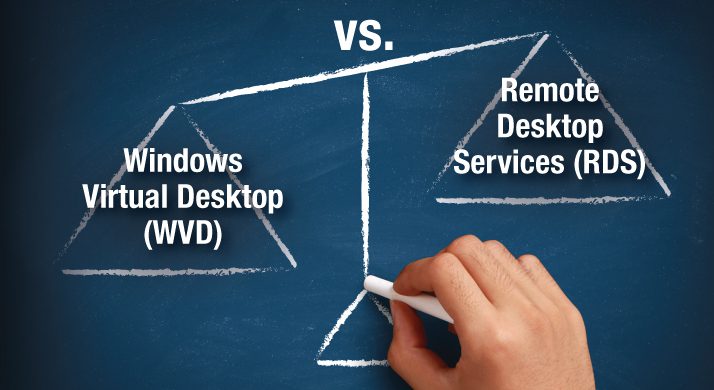WVD vs. RDS: How to choose the remote desktop option in Microsoft Azure that fits you best:
Because of recent networking developments, the answer may surprise you.

This post was updated in January 2021.
To say that a lot has changed over the past year would be an understatement. When we originally published this article, our goal was to provide all the important considerations when deciding whether you should move your Remote Desktop Services (RDS) to Azure or switch to Windows Virtual Desktops (WVD). While these factors are certainly still relevant for your organization to consider, our new working environments point to a more obvious solution.
We’ve seen dramatic shifts in planned cloud usage as organizations scrambled to support remote workers, and are now adopting strategies to support remote and hybrid working models in the future. With working environments that demand accelerated implementation, flexibility, ease of use, and in some cases, expanded footprints, our Cloud Solutions Consultants are highly recommending WVD as a more cost effective and reliable solution than RDS.
Here’s why:
- With WVD, you can quickly achieve a true Virtual Desktop Infrastructure (VDI) Windows 10 experience at a fraction of the cost.
- You can control WVD through Citrix or Horizon, so you can expand your VDI footprint without having to purchase additional hardware to host it. This gives flexibility to spin down expanded VDI footprints once we return to offices or classrooms.
- Many customers are already eligible to use Azure WVD Windows 10 and FSLogix since licensing is already included in M365 E3/E5/A3/A5/F1.
- WVD is easier to set up, manage, and administer.
- WVD offers autoscaling to spin down unused VDI sessions and is based on consumption pricing in the cloud versus the always-on infrastructure model.
Because it’s difficult to switch your environment from 100% on-premises to 100% cloud, the concept of hybrid is more important than ever. Instead of waiting for all use cases to be ready for the cloud, with WVD, companies can direct users to the most appropriate environment for each user on a case-by-case basis and scale their VDI footprint at their own pace. If they are using M365, have Active Directory, and are looking for the best cloud native VDI solution out on the market, the decision is easy.
That said, you ultimately need to decide which technologies are right for you.
If you’re ready to move to Azure, does it make more sense to “lift and shift” (rehost) your existing RDS to Azure? Or should you transition to the modern approach for running virtual desktops on the Azure platform by switching to WVD, the PaaS (re-factor) version of RDS?
Let’s evaluate the situation through the lenses of “technology” and “cost.”
Assess your technology needs: What’s most important to you?
For many, RDS technology evolved well over time and is battle tested. While not perfect, RDS worked well as a hosted desktop solution and alternative to other technologies like Citrix.
You may lean toward continuing with RDS in Azure for the following reasons:
- RDS gives you more control. RDS is tried and true, well understood, and a market-tested solution.
- RDS lets you retain full ownership of not just the desktop virtual machines (VMs) but also the control plane (think RDS roles) that WVD now maintains.
- With Windows 10 Enterprise multi-session under the cover of WVD, applications that were written for RDS on Server OS may not work without updates. If you’re running an application that isn’t supported in a newer version, you can’t move to WVD.
On the flip side, WVD may be more appealing for the following reasons:
- It’s new, up-to-date, and brings the very best of Microsoft as a VDI alternative in Azure, including a native desktop operating system look and feel, as well as managed services.
- It includes user profile container technology acquired by FSLogix to increase profile reliability, letting you maintain users’ bookmarks, shortcuts, and the way their start menu looks.
- It allows for native Windows 10 desktop instead of a Windows 10 “desktop experience” on Server OS with RDS. You always get an up-to-date desktop that offers a familiar desktop user experience.
- WVD Management Service is the control plane that’s hosted and managed by Microsoft in Azure.
- WVD supports OneDrive and indexed search in pooled desktops.
The cost factor: What investments have you made?
Much of the cost approach relies heavily on the investment you may have already made. For example, do you already own a subscription to Windows 10 Enterprise, or are you making an investment into Microsoft 365 anyway?
If the answer to both those questions is “yes”:
- WVD is the winner on cost.
- There is no additional licensing cost for WVD Management Service.
- There is no need for any additional Azure VMs to run the control plane.
However, if you don’t own Windows 10 Enterprise subscription and aren’t planning on purchasing it for any reason other than potentially using WVD, then you should know:
- RDS and WVD are very similar in cost.
- The incremental cost of Windows 10 Enterprise E3 subscription versus the incremental cost of RDS SAL & Server 2016 license is very similar.
- RDS may be the winner only if you have 25 or less desktop users. Although there are savings per user per month, there are also costs for RDS infrastructure VMs. If you have very few desktop users, the cost of these additional VMs may exceed the per-user savings.
Modernize your desktop infrastructure in Azure
The truth is the choice you make may very well come down to your personal philosophy.
Microsoft WVD in Azure does simplify the deployment and licensing model of virtual desktops in the cloud. As we’ve seen with organizations moving toward Microsoft 365 and Azure, it’s a natural and relatively low-cost way to deploy desktops and applications in the cloud.
Then again, if your stance is, “if it isn’t broke, don’t fix it,” you may feel more comfortable simply lifting and shifting your current RDS to Azure.
For more information about SHI’s cloud solutions, or for help evaluating what technology is best for your organization, contact SHI.
Carlos Borges contributed to this post.





